Saturday, 23 June, Gégène and Jenny
Written 30 July 2018
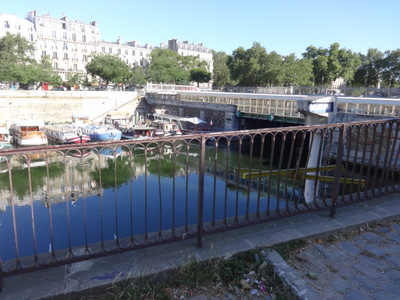
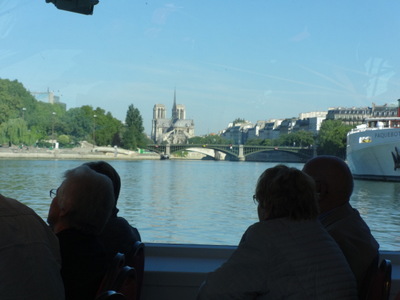 Saturday, poor David had to get up early again, because we were scheduled for our second river day-cruise, this time up the Seine to a a famous restaurant—one of the few surviving original guinguettes—Chez Gégène (Gégène is a diminutive form of Eugene).
Saturday, poor David had to get up early again, because we were scheduled for our second river day-cruise, this time up the Seine to a a famous restaurant—one of the few surviving original guinguettes—Chez Gégène (Gégène is a diminutive form of Eugene).
It departed from the Port de l'Arsenal, Paris's pleasure-boat marina, right next to the Place de la Bastille, so we just took the #8 metro three stops down and walked across the place. The view at the left is from street level, before we climbed down to the water level. The row of windows above the water is actually the wall of the Bastille metro station, which overlooks the marina. All the boats that rent space in the marina. about 170 all told, must leave it for a few days at least once a year, to prove that they are in fact still boats and not permanent installations. Many just cruise up to the Basin de la Villette and spend a while there. As a result, a few berths are sometimes available for visiting vessels.
Note that in French "arsenal" means "shipyard," and not a place where weapons are stored. The port is actually the mouth of the Canal St. Martin, which starts up in the northeast corner of Paris at the Basin de la Villette and flows south, then dives underground and is roofed over by the Boulevard Richard Lenoir until it passes under the Place de la Bastille and emerges at Arsenal. We took a half-day Canauxrama cruise on it a few years ago.
The boat that appeared to pick us up was the Henri IV, the very same vessel that took us downstream the week before. We had the same captain, but a new guide, who admitted this was her first trip. To get from the arsenal basin out onto the Seine, we had to pass through a lock (the basin is lower than the river), and the guide promised us a nice view of Notre Dame cathedral as we emerged. The photo at the right proved her correct.

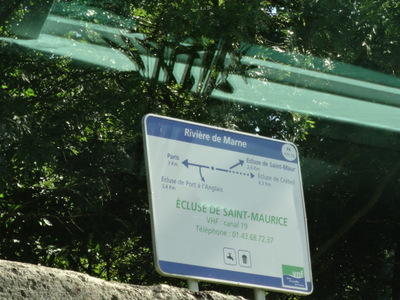
Once out on the river, we turned upstream (i.e. east) and cruised toward guiguette country. Almost before we'd "rounded the curve" leaving Paris proper, we branched to the left onto the Marne, which according to the French is not a "fleuve" (a river) but a "rivière" (a tributary), because it flows into the Seine rather than extending to the sea. Things were pretty urban at first (although I got all my better photos of that section on the way back, and even those are seriously marred by the relentless reflections in the windows), but once we passed the St. Maurice lock on the Marne, we found ourselves in the country (or at least in wooded suburbs), even though the Marne turned north and hugged the eastern edge of the city for quite a while.
While we were still in the city, we passed a few things I never did get good photos of. One was the city's garbage incinerator, which is proud to emit only water vapor from its smokestacks. All the grunge it filters out of the smoke is collected and called "mâchefer" and is made into paving material.
Another was the old city compressed-air plant. Back in the day (actually up to the 1980's, by which time it had gotten really expensive, like $180 a pop), letters could be whooshed across Paris through underground pneumatic tubes (like those you might see in an old-fashioned department store taking cash to the central till), and this one plant supplied all the compressed air needed to push them!
A third was the Nef Paris. Some time back, boat races were staged in which each French city was represented by a wooden boat. The one that represented Paris is now falling to ruin in the Seine and wsa pointed out to us in passing.
Finally, near the Saint-Maurice Lock we were told we were passing near the Fragonard Museum. Before all you art lovers get excited, realize that this is not the painter but his cousin, who plastinated people. I've never been there, but I'm told you can see any number of preserved cadavers, including the famous flayed horse and rider.
We rose with each lock, of course, because we were cruising upstream, so here the lock-keeper's office is far above us as we entered. At each lock, a sign like the one at the right reminded the navigator where he was (i.e., which lock he was in) and gave a diagrammatic map of nearby waterways and distances to the next locks up- and down-stream.
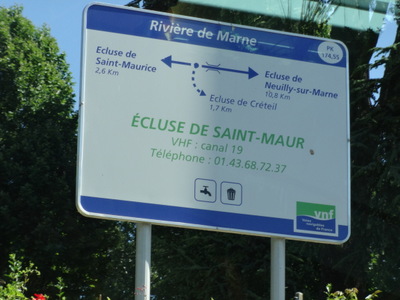
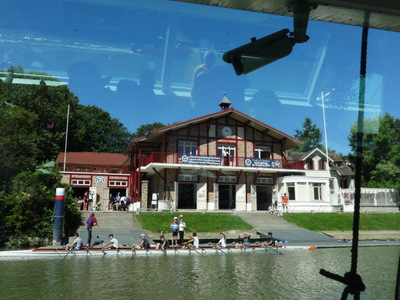 Our next lock was the St. Maur (where the cheese comes from, I guess, though I always associated it with the valley of the Loire . . .).
Our next lock was the St. Maur (where the cheese comes from, I guess, though I always associated it with the valley of the Loire . . .).
At the right here is one of many very elaborate boathouses we passed, devoted to rowing, which seems to be very popular. Unlike most of the others, this one didn't seem to proclaim the name of the club in big letters, but banners proclaimed "5 champions of France in 2016/2017, 1 rower at Rio, 2 at the championships of Europe and the world, 1500 participants" and "Pauline & Antoine [with photos of their smiling faces] champions of France 2017." One of their eights, the Alain Perriez, full of teenage boys (some waving at us), is pulled up to the dock. The girl standing on the dock near the stern may be their cox.
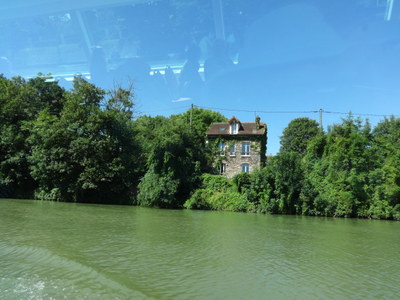
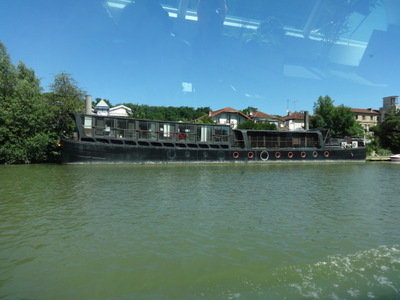 This little stone cottage, clearly still occupied and kept up, looks like the old lock-keepers' houses we've seen all over France. I wonder whether it once supervised the lock leading from a smaller stream into the river.
This little stone cottage, clearly still occupied and kept up, looks like the old lock-keepers' houses we've seen all over France. I wonder whether it once supervised the lock leading from a smaller stream into the river.
At the right is a long barge, painted entirely black, that was probably once a cargo ship but is now fitted up as a cruising restaurant.

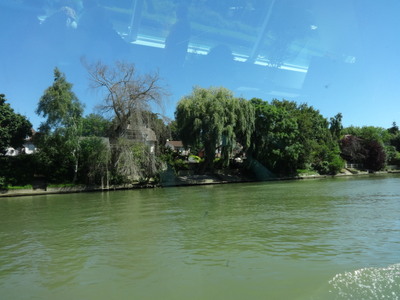 Here's another boathouse, this one apparently deserted, even on a Saturday afternoon but proud to proclaim itself "Aviron de Joinville," "Joinville Rowing." The smaller greenish sign below the tall vertical window says "Regional Bridge Committee" (the card game, not the means of crossing waterways).
Here's another boathouse, this one apparently deserted, even on a Saturday afternoon but proud to proclaim itself "Aviron de Joinville," "Joinville Rowing." The smaller greenish sign below the tall vertical window says "Regional Bridge Committee" (the card game, not the means of crossing waterways).
At the right is a particularly picturesque set of plantings below the yards of riverside houses in an affluent neighborhood. The guide first puzzled the passengers by saying that this was housing for the SDF ("sans domicile fixe," meaning "homeless" in French), then cracked them up by revealing that in this area it stood for "sans diffcultés financières," "without financial difficulties."
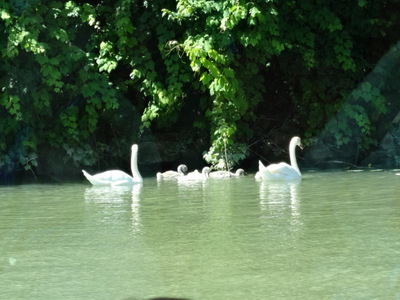
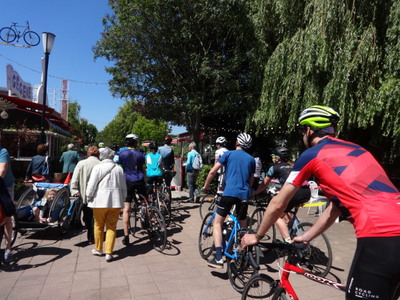 Along the way, we passed this pair of swans with half-grown cygnets. These were the only babies we saw, but many adult swans swam by, singly and in pairs.
Along the way, we passed this pair of swans with half-grown cygnets. These were the only babies we saw, but many adult swans swam by, singly and in pairs.
After cruising a short ways beyond our destination restaurant, the captain swung the boat around and came back to tie up at its dock. As you can see from the photo at the right, the towpath was bustling on this cool, sunny Saturday. The bicyclists practically had to elbow their way through the crowds of joggers, walkers, and once we arrived, cruisers.

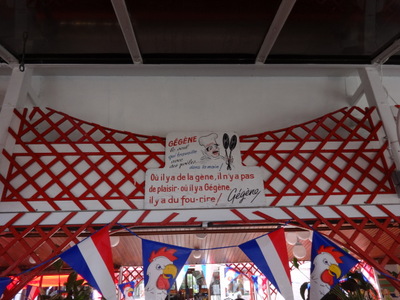 As you can see from its façade and entryway, Chez Gégène does not pretend to high-end fine dining. If the bicycle on top didn't give it away, the giant cut-out of a chef mounted on the roof would.
As you can see from its façade and entryway, Chez Gégène does not pretend to high-end fine dining. If the bicycle on top didn't give it away, the giant cut-out of a chef mounted on the roof would.
The little poem over the entryway, above the colored flags, reads, "Où il y a de la gène, il n'y a pas de plaisir. Où il y a Gégène, il y a du fou-rire." That is, "Where there is pain, there is no pleasure. Where there is Gégène, there is crazy-laughter" (i.e., we laugh ourselves crazy).
The reason Parisians of a hundred years ago came out to the suburbs on weekends to drink and party was that the city taxed all wine that entered the city limits, so the tax-free wine outside the city was way cheaper. One story of the origin of the word "guingette" is from "guinguet," a sour local wine that was popular there. Because the river winds so much, we weren't really that far from the city. The Bastille Opera house was built on the site of a train station, now demolished, that served this area. The elevated tracks of that line are now the Promenade Plantée, whose name was recently changed to the "Coulée Verte," a sort of linear elevated garden, great for strolling.
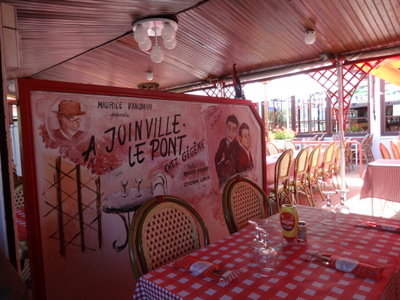
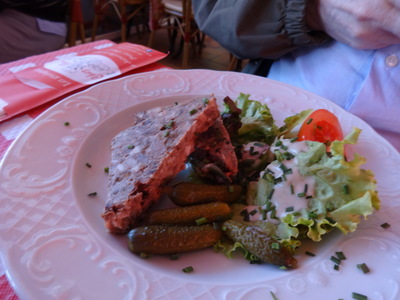 This nearby banquette back was painted with a poster for a musical movie called "Joinville le Pont," which apparently featured the restaurant. It seems to have been a favorite movie location.
This nearby banquette back was painted with a poster for a musical movie called "Joinville le Pont," which apparently featured the restaurant. It seems to have been a favorite movie location.
David started with country-style pâté accompanied by cornichons (small nondill sour pickles) and a small salad. Mustard was on the table.
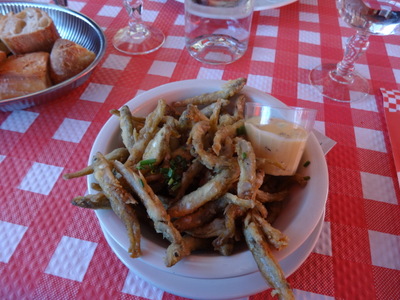
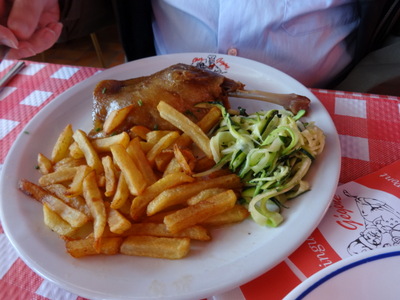 I started with "friture de joëls," whole fried tiny fish (Atherina boyeri, big-scale sand smelts, the name is longer than the fish), with Béarnaise sauce for dipping. They were a little chewier than the ideal, but tasty nonetheless.
I started with "friture de joëls," whole fried tiny fish (Atherina boyeri, big-scale sand smelts, the name is longer than the fish), with Béarnaise sauce for dipping. They were a little chewier than the ideal, but tasty nonetheless.
David's main course was a leg of duck confit with fries and two-tone shredded zucchini, which he declared very good.
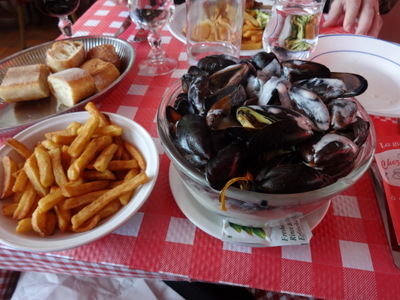
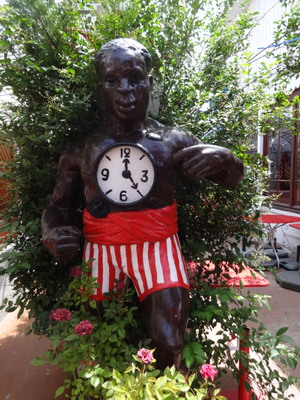 I had mussels with cream, which also came with fries.
I had mussels with cream, which also came with fries.
Nearby, in a little tuft of shrubbery, where it greeted those on the way to the restrooms, was this rather startling clock, set for some reason in the chest of a boxer. I just photograph 'em; I don't explain 'em."
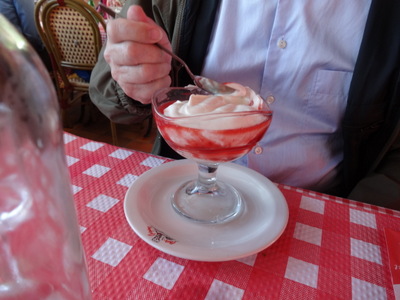
 For dessert, David had his beloved fromage blanc with red fruit coulis.
For dessert, David had his beloved fromage blanc with red fruit coulis.
I'd been having very good luck with strawberries, and two options were offered: with whipped cream and with sugar. For some reason, I was not in the mood for whipped cream (and that doesn't happen often), so I went for the sugar option. I groaned inwardly when they showed up with this lovely dish of strawberries but only two little packets of sugar. As it happens, I only used one of the sugar packets and thoroughly enjoyed the berries, which were superb. Why can't American growers grow strawberries like that?! (Answer: they take too much work to grow and too much care to ship; ours are bred only to grow like weeds and bounce without bruising when dropped.)
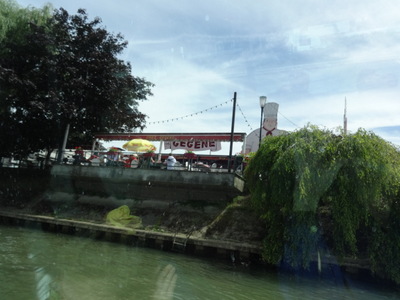
 Here's a parting shot of Chez Gégène, from the river as we sailed away. Notice the terrace full of café tables cantilevered out over the water.
Here's a parting shot of Chez Gégène, from the river as we sailed away. Notice the terrace full of café tables cantilevered out over the water.
This sign marks the mouth of the Saint-Maur Tunnel, almost 600 m long, which we passed through coming and going.

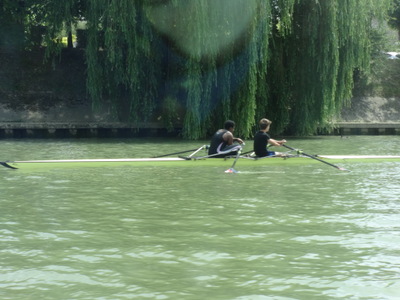 Here's another rowing club, called something starting with "M," judging by the sign. It shows some signs of activity, and the double that rowed by near it presumably came from there.
Here's another rowing club, called something starting with "M," judging by the sign. It shows some signs of activity, and the double that rowed by near it presumably came from there.

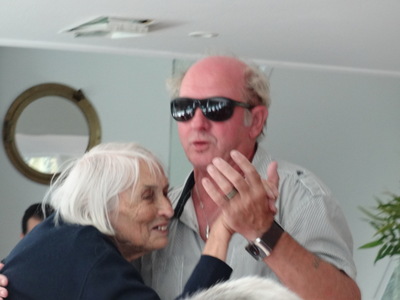 As on the previous cruise, we got accordeon music all the way back, from Jan, the very same accordeonist we had before. (This time he played both La Vie en Rose and Paris Skies, though he didn't open with either one). This time he had more luck getting people to dance. We were once again accompanied by a group of French tourists of about our age (not the same group as before), and they seemed much more the dancing type. In the left-hand photo, the guy in the left-hand couple (mostly hidden by his wife in this shot) was what we call your classic French Wag. He cut up, teased everybody, and generally created great hilarity throughout the cruise (to the point where his wife made him apologize to us at lunch time, in case he had gotten too familiar (we actually thought he was hilarious).
As on the previous cruise, we got accordeon music all the way back, from Jan, the very same accordeonist we had before. (This time he played both La Vie en Rose and Paris Skies, though he didn't open with either one). This time he had more luck getting people to dance. We were once again accompanied by a group of French tourists of about our age (not the same group as before), and they seemed much more the dancing type. In the left-hand photo, the guy in the left-hand couple (mostly hidden by his wife in this shot) was what we call your classic French Wag. He cut up, teased everybody, and generally created great hilarity throughout the cruise (to the point where his wife made him apologize to us at lunch time, in case he had gotten too familiar (we actually thought he was hilarious).
He danced indefatigably. When his wife sat down, he danced with anybody else he could get to stand up. But when the accordeonist struck up a classic song (everybody but David and me knew the words) that went, in my translation, "Would you like to dance grandma, . . . the way you did when you were 20 . . . ," he immediately went all serious and with great care and tenderness led this little old lady around the floor, much to her delight. I have no idea whether they even knew each other.

 By the time we got back to Arsenal, the middle-aged ladies were up on the floor line dancing!
By the time we got back to Arsenal, the middle-aged ladies were up on the floor line dancing!
On this trip, we saw fewer birds, probably because the banks were less wild: starlings, mallards, swans, some Canada geese, cormorants, wood pigeons, and a single, mostly white domestic goose. The guide said we might see herons cendrées, but I didn't.

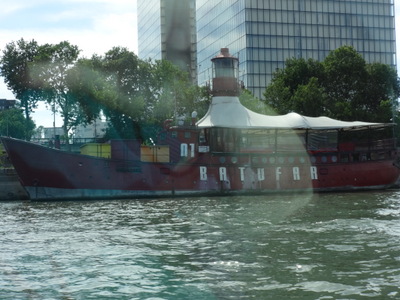 The image at the left here is of Chinagora, a commercial center designed specifically to attract and accommodate Asian businesses—note the pagoda-style roof line of this wing. Unfortunately for the developers, it proved to be too far from the center of the city to be attractive and has now been sold and put to some other use, although the name has been retained.
The image at the left here is of Chinagora, a commercial center designed specifically to attract and accommodate Asian businesses—note the pagoda-style roof line of this wing. Unfortunately for the developers, it proved to be too far from the center of the city to be attractive and has now been sold and put to some other use, although the name has been retained.
At the right is "Batofar," now some sort of nightclub or restaurant, but originally an actual floating lighthouse. The name is a phonetic spelling of "bâteau phare," meaning "lighthouse boat." It and several others like it were used to mark navigational hazards in the river that tended to move, like shifting sand bars; it could be moved to follow them wherever they drifted.
Somewhere along the way, the guide mentioned a building in the shape of a bottle of Suze (by the Suze company, I think) which was later sold and is now a church, but I never got a sight of it and haven't been able to find any reference to it on line. Any of you readers have a clue?
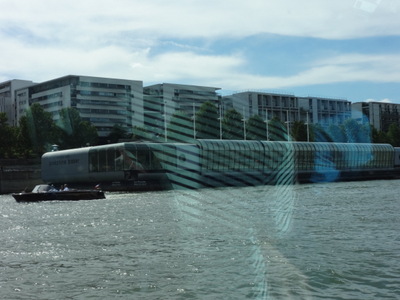
 The long, low structure in the left-hand photo is a swimming pool, named for Josephine Baker, which actually floats on the Seine, the level of water in the pool more or less level with that of the river. The guide emphasized that it is the only swimming pool in the world ever to have sunk. It seems that one day the pumps malfunctioned and wouldn't shut off. The filled the entire structure with water, sinking it to the bottom. It has since been emptied, refloated, and put back into service. The roof was closed when we saw it, but photos on the web reveal that its two halves can slide apart, opening the center section up.
The long, low structure in the left-hand photo is a swimming pool, named for Josephine Baker, which actually floats on the Seine, the level of water in the pool more or less level with that of the river. The guide emphasized that it is the only swimming pool in the world ever to have sunk. It seems that one day the pumps malfunctioned and wouldn't shut off. The filled the entire structure with water, sinking it to the bottom. It has since been emptied, refloated, and put back into service. The roof was closed when we saw it, but photos on the web reveal that its two halves can slide apart, opening the center section up.
We also cruised by the Louisiane Belle, a stern wheeler that can be rented for dinner cruises, weddings, etc. Who knows what the kitchen serves?! Andouillette de Troyes with curry sauce, maybe . . .
Written 31 July 2018

 At last we arrived back at Arsenal and passed back through the lock into the marina. Straight ahead, beyond the bridge, that's the July column in the center of the Place de la Bastille.
At last we arrived back at Arsenal and passed back through the lock into the marina. Straight ahead, beyond the bridge, that's the July column in the center of the Place de la Bastille.
The photo at the right shows the quai at which the boat ties up. At the left-hand edge of the photo, you can see the last few windows of the Bastille metro station and, above them, part of the Bastille Opera building. The guide told us that, last spring, the Seine flooded so badly that water poured into the marina over the tops of the lock doors. The water level didn't reach the metro station or the street, but it completely covered the quai to a considerable depth, damaged some boats that were tied up a little too closely, and washed away the Canauxrama ticket office, which is a little blue wooden kiosk about the size of two telephone booths. The new one is out of sight to the right of the photo.
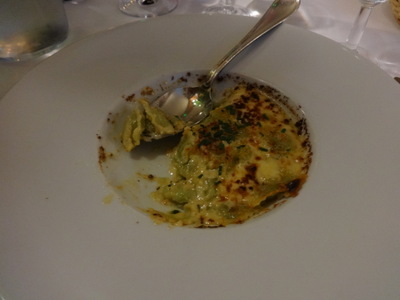
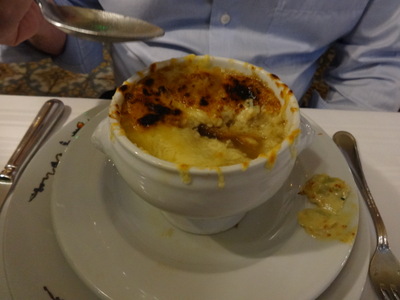 For supper, we strolled up to the Place de la République to try Chez Jenny, a traditional Alsatian seafood and sauerkraut restaurant. It makes sense that Alsatian brasseries should serve sauerkraut, flammeküche, etc., but why do they all also feature huge platters of cold seafood? It's a mystery to me.
For supper, we strolled up to the Place de la République to try Chez Jenny, a traditional Alsatian seafood and sauerkraut restaurant. It makes sense that Alsatian brasseries should serve sauerkraut, flammeküche, etc., but why do they all also feature huge platters of cold seafood? It's a mystery to me.
I started with a gratin of ravioles du Dauphiné, which was outstanding! These ravioles (not, the folks of the Dauphiné insist, "ravioli") are postage-stamp-sized squares of pasta stuffed with something green, cheese and chives, I think. We'd never heard of them until a few years ago; now they're everywhere!
David had the traditional onion soup with croutons and cheese on top.

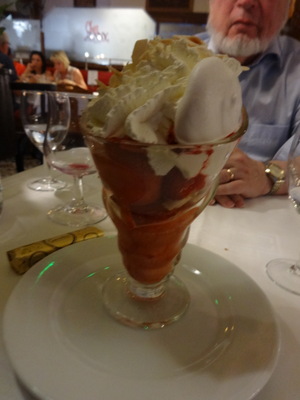 Then we each had a flammeküche, a sort of Alsatian pizza of lardons, onions, fromage blanc, and crême fraîche on a crisp, cracker-thin crust. They weren't bad, but we've had better (in Strasbourg).
Then we each had a flammeküche, a sort of Alsatian pizza of lardons, onions, fromage blanc, and crême fraîche on a crisp, cracker-thin crust. They weren't bad, but we've had better (in Strasbourg).
I then couldn't resist the coffee, caramel, and rhum raisin ice cream!
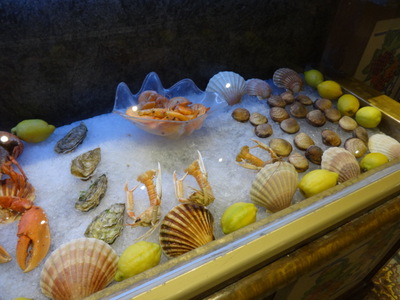

On the way out, I got this shot of the seafood case, looking pretty picked over by the end of the evening, and then this nice twilight photo of the statue in the center of the Place de la République as we strolled home.
Previous entry
List of Entries
Next entry

 Saturday, poor David had to get up early again, because we were scheduled for our second river day-cruise, this time up the Seine to a a famous restaurant—one of the few surviving original guinguettes—Chez Gégène (Gégène is a diminutive form of Eugene).
Saturday, poor David had to get up early again, because we were scheduled for our second river day-cruise, this time up the Seine to a a famous restaurant—one of the few surviving original guinguettes—Chez Gégène (Gégène is a diminutive form of Eugene).


 Our next lock was the St. Maur (where the cheese comes from, I guess, though I always associated it with the valley of the Loire . . .).
Our next lock was the St. Maur (where the cheese comes from, I guess, though I always associated it with the valley of the Loire . . .).
 This little stone cottage, clearly still occupied and kept up, looks like the old lock-keepers' houses we've seen all over France. I wonder whether it once supervised the lock leading from a smaller stream into the river.
This little stone cottage, clearly still occupied and kept up, looks like the old lock-keepers' houses we've seen all over France. I wonder whether it once supervised the lock leading from a smaller stream into the river.
 Here's another boathouse, this one apparently deserted, even on a Saturday afternoon but proud to proclaim itself "Aviron de Joinville," "Joinville Rowing." The smaller greenish sign below the tall vertical window says "Regional Bridge Committee" (the card game, not the means of crossing waterways).
Here's another boathouse, this one apparently deserted, even on a Saturday afternoon but proud to proclaim itself "Aviron de Joinville," "Joinville Rowing." The smaller greenish sign below the tall vertical window says "Regional Bridge Committee" (the card game, not the means of crossing waterways).
 Along the way, we passed this pair of swans with half-grown cygnets. These were the only babies we saw, but many adult swans swam by, singly and in pairs.
Along the way, we passed this pair of swans with half-grown cygnets. These were the only babies we saw, but many adult swans swam by, singly and in pairs.
 As you can see from its façade and entryway, Chez Gégène does not pretend to high-end fine dining. If the bicycle on top didn't give it away, the giant cut-out of a chef mounted on the roof would.
As you can see from its façade and entryway, Chez Gégène does not pretend to high-end fine dining. If the bicycle on top didn't give it away, the giant cut-out of a chef mounted on the roof would.
 This nearby banquette back was painted with a poster for a musical movie called "Joinville le Pont," which apparently featured the restaurant. It seems to have been a favorite movie location.
This nearby banquette back was painted with a poster for a musical movie called "Joinville le Pont," which apparently featured the restaurant. It seems to have been a favorite movie location. 
 I started with "friture de joëls," whole fried tiny fish (Atherina boyeri, big-scale sand smelts, the name is longer than the fish), with Béarnaise sauce for dipping. They were a little chewier than the ideal, but tasty nonetheless.
I started with "friture de joëls," whole fried tiny fish (Atherina boyeri, big-scale sand smelts, the name is longer than the fish), with Béarnaise sauce for dipping. They were a little chewier than the ideal, but tasty nonetheless.
 I had mussels with cream, which also came with fries.
I had mussels with cream, which also came with fries.
 For dessert, David had his beloved fromage blanc with red fruit coulis.
For dessert, David had his beloved fromage blanc with red fruit coulis.
 Here's a parting shot of Chez Gégène, from the river as we sailed away. Notice the terrace full of café tables cantilevered out over the water.
Here's a parting shot of Chez Gégène, from the river as we sailed away. Notice the terrace full of café tables cantilevered out over the water.
 Here's another rowing club, called something starting with "M," judging by the sign. It shows some signs of activity, and the double that rowed by near it presumably came from there.
Here's another rowing club, called something starting with "M," judging by the sign. It shows some signs of activity, and the double that rowed by near it presumably came from there.
 As on the previous cruise, we got accordeon music all the way back, from Jan, the very same accordeonist we had before. (This time he played both La Vie en Rose and Paris Skies, though he didn't open with either one). This time he had more luck getting people to dance. We were once again accompanied by a group of French tourists of about our age (not the same group as before), and they seemed much more the dancing type. In the left-hand photo, the guy in the left-hand couple (mostly hidden by his wife in this shot) was what we call your classic French Wag. He cut up, teased everybody, and generally created great hilarity throughout the cruise (to the point where his wife made him apologize to us at lunch time, in case he had gotten too familiar (we actually thought he was hilarious).
As on the previous cruise, we got accordeon music all the way back, from Jan, the very same accordeonist we had before. (This time he played both La Vie en Rose and Paris Skies, though he didn't open with either one). This time he had more luck getting people to dance. We were once again accompanied by a group of French tourists of about our age (not the same group as before), and they seemed much more the dancing type. In the left-hand photo, the guy in the left-hand couple (mostly hidden by his wife in this shot) was what we call your classic French Wag. He cut up, teased everybody, and generally created great hilarity throughout the cruise (to the point where his wife made him apologize to us at lunch time, in case he had gotten too familiar (we actually thought he was hilarious).
 By the time we got back to Arsenal, the middle-aged ladies were up on the floor line dancing!
By the time we got back to Arsenal, the middle-aged ladies were up on the floor line dancing!
 The image at the left here is of Chinagora, a commercial center designed specifically to attract and accommodate Asian businesses—note the pagoda-style roof line of this wing. Unfortunately for the developers, it proved to be too far from the center of the city to be attractive and has now been sold and put to some other use, although the name has been retained.
The image at the left here is of Chinagora, a commercial center designed specifically to attract and accommodate Asian businesses—note the pagoda-style roof line of this wing. Unfortunately for the developers, it proved to be too far from the center of the city to be attractive and has now been sold and put to some other use, although the name has been retained.

 The long, low structure in the left-hand photo is a swimming pool, named for Josephine Baker, which actually floats on the Seine, the level of water in the pool more or less level with that of the river. The guide emphasized that it is the only swimming pool in the world ever to have sunk. It seems that one day the pumps malfunctioned and wouldn't shut off. The filled the entire structure with water, sinking it to the bottom. It has since been emptied, refloated, and put back into service. The roof was closed when we saw it, but photos on the web reveal that its two halves can slide apart, opening the center section up.
The long, low structure in the left-hand photo is a swimming pool, named for Josephine Baker, which actually floats on the Seine, the level of water in the pool more or less level with that of the river. The guide emphasized that it is the only swimming pool in the world ever to have sunk. It seems that one day the pumps malfunctioned and wouldn't shut off. The filled the entire structure with water, sinking it to the bottom. It has since been emptied, refloated, and put back into service. The roof was closed when we saw it, but photos on the web reveal that its two halves can slide apart, opening the center section up.
 At last we arrived back at Arsenal and passed back through the lock into the marina. Straight ahead, beyond the bridge, that's the July column in the center of the Place de la Bastille.
At last we arrived back at Arsenal and passed back through the lock into the marina. Straight ahead, beyond the bridge, that's the July column in the center of the Place de la Bastille.
 For supper, we strolled up to the Place de la République to try Chez Jenny, a traditional Alsatian seafood and sauerkraut restaurant. It makes sense that Alsatian brasseries should serve sauerkraut, flammeküche, etc., but why do they all also feature huge platters of cold seafood? It's a mystery to me.
For supper, we strolled up to the Place de la République to try Chez Jenny, a traditional Alsatian seafood and sauerkraut restaurant. It makes sense that Alsatian brasseries should serve sauerkraut, flammeküche, etc., but why do they all also feature huge platters of cold seafood? It's a mystery to me.

 Then we each had a flammeküche, a sort of Alsatian pizza of lardons, onions, fromage blanc, and crême fraîche on a crisp, cracker-thin crust. They weren't bad, but we've had better (in Strasbourg).
Then we each had a flammeküche, a sort of Alsatian pizza of lardons, onions, fromage blanc, and crême fraîche on a crisp, cracker-thin crust. They weren't bad, but we've had better (in Strasbourg).
